Developing an Accounting Information System for Elegant Firm
VerifiedAdded on 2023/06/12
|9
|1523
|350
Report
AI Summary
This report details the development of an accounting information system (AIS) for Elegant Firm, addressing the roles of management and users in the system's design and implementation. It highlights the importance of management in guiding the development process and defining system functionality, while emphasizing the crucial role of end-users in providing feedback and ensuring the system meets their needs. The report outlines the benefits of installing a new AIS, including modernizing the IT infrastructure and mitigating financial challenges. It describes a predictive approach to system development, involving requirement gathering, design, implementation, verification, and maintenance. Furthermore, it includes a Level 0 Data Flow Diagram and a flowchart illustrating the payroll process within Elegant Firm. The report concludes that adopting an AIS will significantly benefit Elegant Firm by enhancing efficiency and effectiveness in its accounting operations.
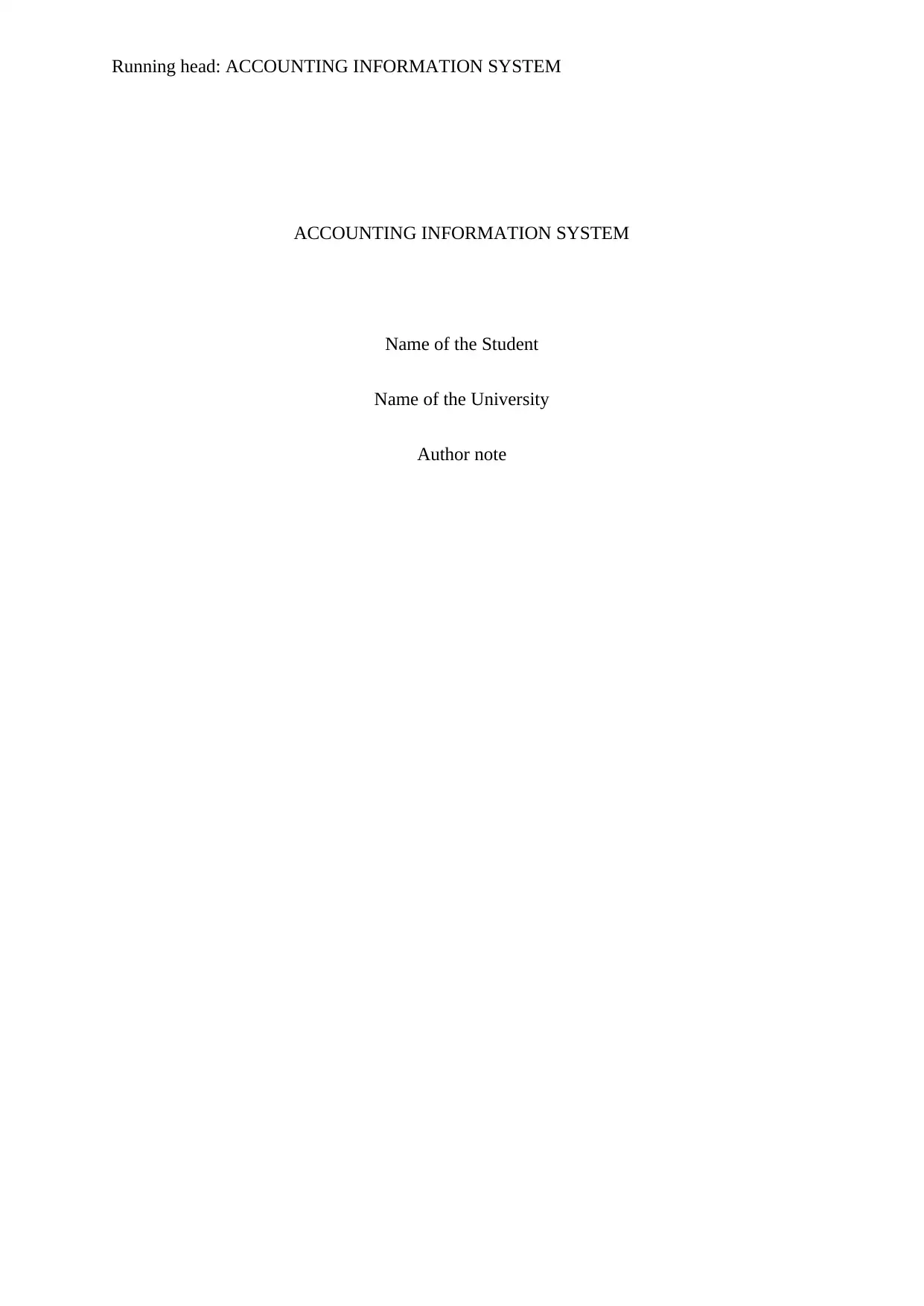
Running head: ACCOUNTING INFORMATION SYSTEM
ACCOUNTING INFORMATION SYSTEM
Name of the Student
Name of the University
Author note
ACCOUNTING INFORMATION SYSTEM
Name of the Student
Name of the University
Author note
Paraphrase This Document
Need a fresh take? Get an instant paraphrase of this document with our AI Paraphraser
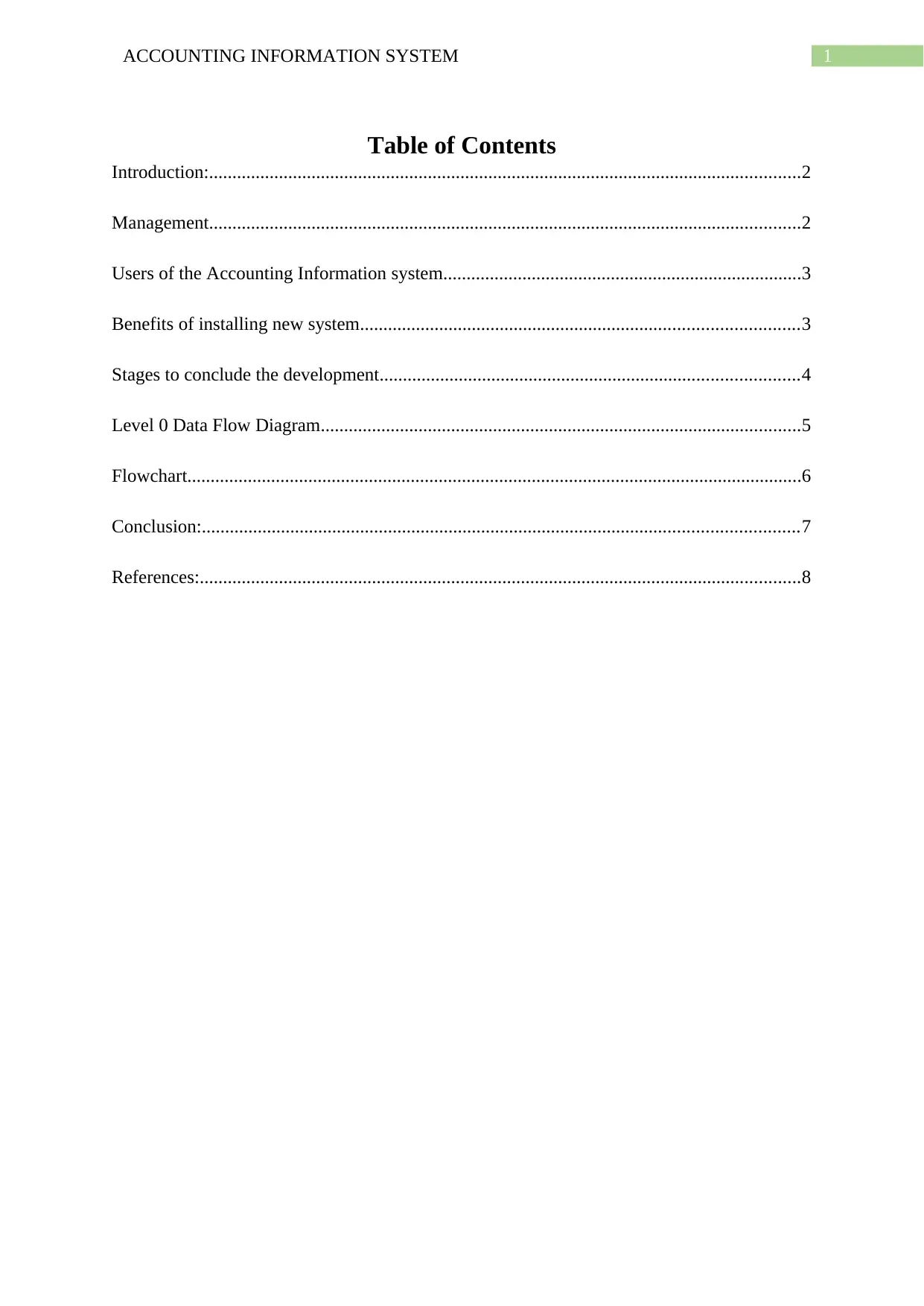
1ACCOUNTING INFORMATION SYSTEM
Table of Contents
Introduction:...............................................................................................................................2
Management...............................................................................................................................2
Users of the Accounting Information system.............................................................................3
Benefits of installing new system..............................................................................................3
Stages to conclude the development..........................................................................................4
Level 0 Data Flow Diagram.......................................................................................................5
Flowchart....................................................................................................................................6
Conclusion:................................................................................................................................7
References:.................................................................................................................................8
Table of Contents
Introduction:...............................................................................................................................2
Management...............................................................................................................................2
Users of the Accounting Information system.............................................................................3
Benefits of installing new system..............................................................................................3
Stages to conclude the development..........................................................................................4
Level 0 Data Flow Diagram.......................................................................................................5
Flowchart....................................................................................................................................6
Conclusion:................................................................................................................................7
References:.................................................................................................................................8
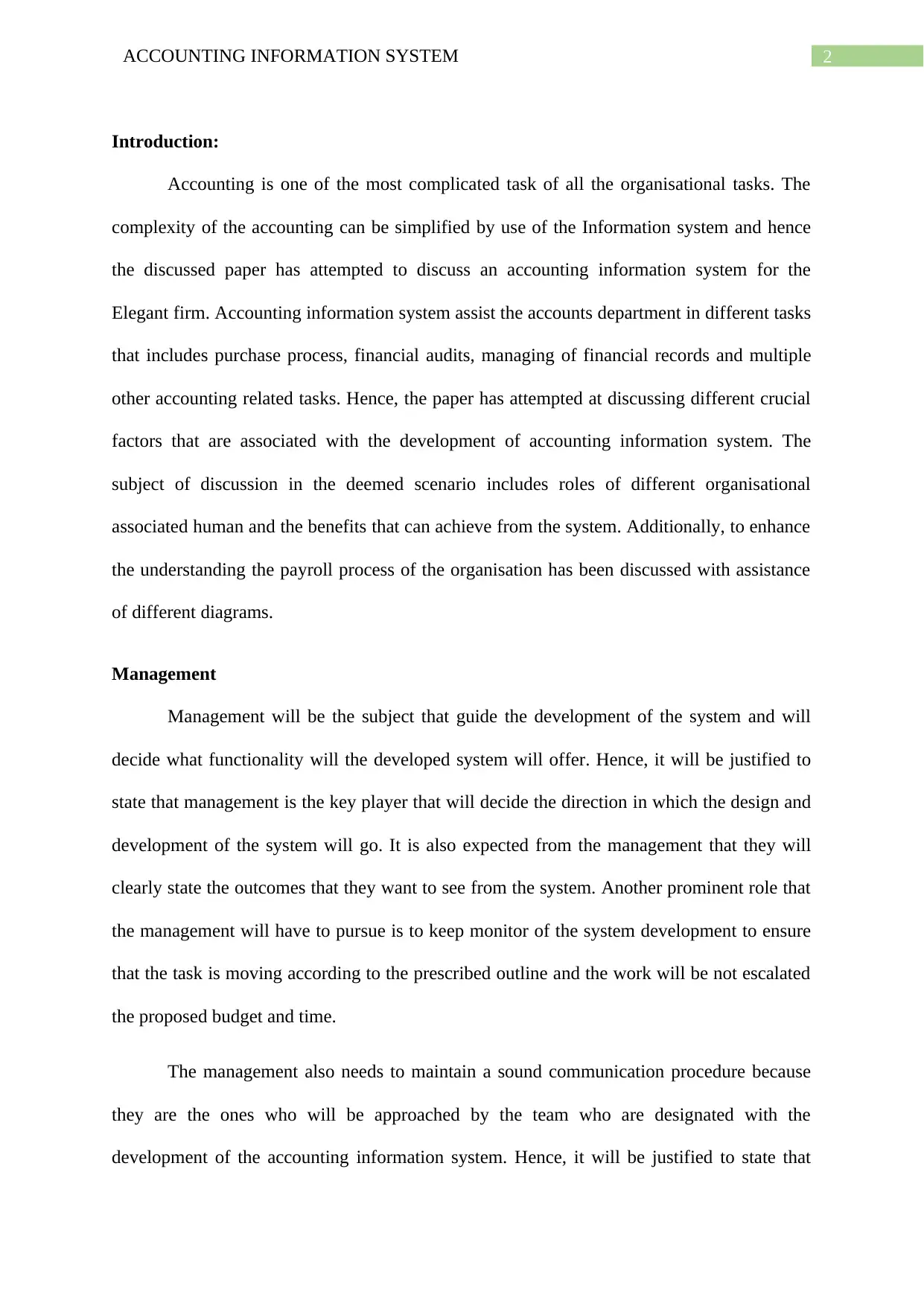
2ACCOUNTING INFORMATION SYSTEM
Introduction:
Accounting is one of the most complicated task of all the organisational tasks. The
complexity of the accounting can be simplified by use of the Information system and hence
the discussed paper has attempted to discuss an accounting information system for the
Elegant firm. Accounting information system assist the accounts department in different tasks
that includes purchase process, financial audits, managing of financial records and multiple
other accounting related tasks. Hence, the paper has attempted at discussing different crucial
factors that are associated with the development of accounting information system. The
subject of discussion in the deemed scenario includes roles of different organisational
associated human and the benefits that can achieve from the system. Additionally, to enhance
the understanding the payroll process of the organisation has been discussed with assistance
of different diagrams.
Management
Management will be the subject that guide the development of the system and will
decide what functionality will the developed system will offer. Hence, it will be justified to
state that management is the key player that will decide the direction in which the design and
development of the system will go. It is also expected from the management that they will
clearly state the outcomes that they want to see from the system. Another prominent role that
the management will have to pursue is to keep monitor of the system development to ensure
that the task is moving according to the prescribed outline and the work will be not escalated
the proposed budget and time.
The management also needs to maintain a sound communication procedure because
they are the ones who will be approached by the team who are designated with the
development of the accounting information system. Hence, it will be justified to state that
Introduction:
Accounting is one of the most complicated task of all the organisational tasks. The
complexity of the accounting can be simplified by use of the Information system and hence
the discussed paper has attempted to discuss an accounting information system for the
Elegant firm. Accounting information system assist the accounts department in different tasks
that includes purchase process, financial audits, managing of financial records and multiple
other accounting related tasks. Hence, the paper has attempted at discussing different crucial
factors that are associated with the development of accounting information system. The
subject of discussion in the deemed scenario includes roles of different organisational
associated human and the benefits that can achieve from the system. Additionally, to enhance
the understanding the payroll process of the organisation has been discussed with assistance
of different diagrams.
Management
Management will be the subject that guide the development of the system and will
decide what functionality will the developed system will offer. Hence, it will be justified to
state that management is the key player that will decide the direction in which the design and
development of the system will go. It is also expected from the management that they will
clearly state the outcomes that they want to see from the system. Another prominent role that
the management will have to pursue is to keep monitor of the system development to ensure
that the task is moving according to the prescribed outline and the work will be not escalated
the proposed budget and time.
The management also needs to maintain a sound communication procedure because
they are the ones who will be approached by the team who are designated with the
development of the accounting information system. Hence, it will be justified to state that
⊘ This is a preview!⊘
Do you want full access?
Subscribe today to unlock all pages.

Trusted by 1+ million students worldwide
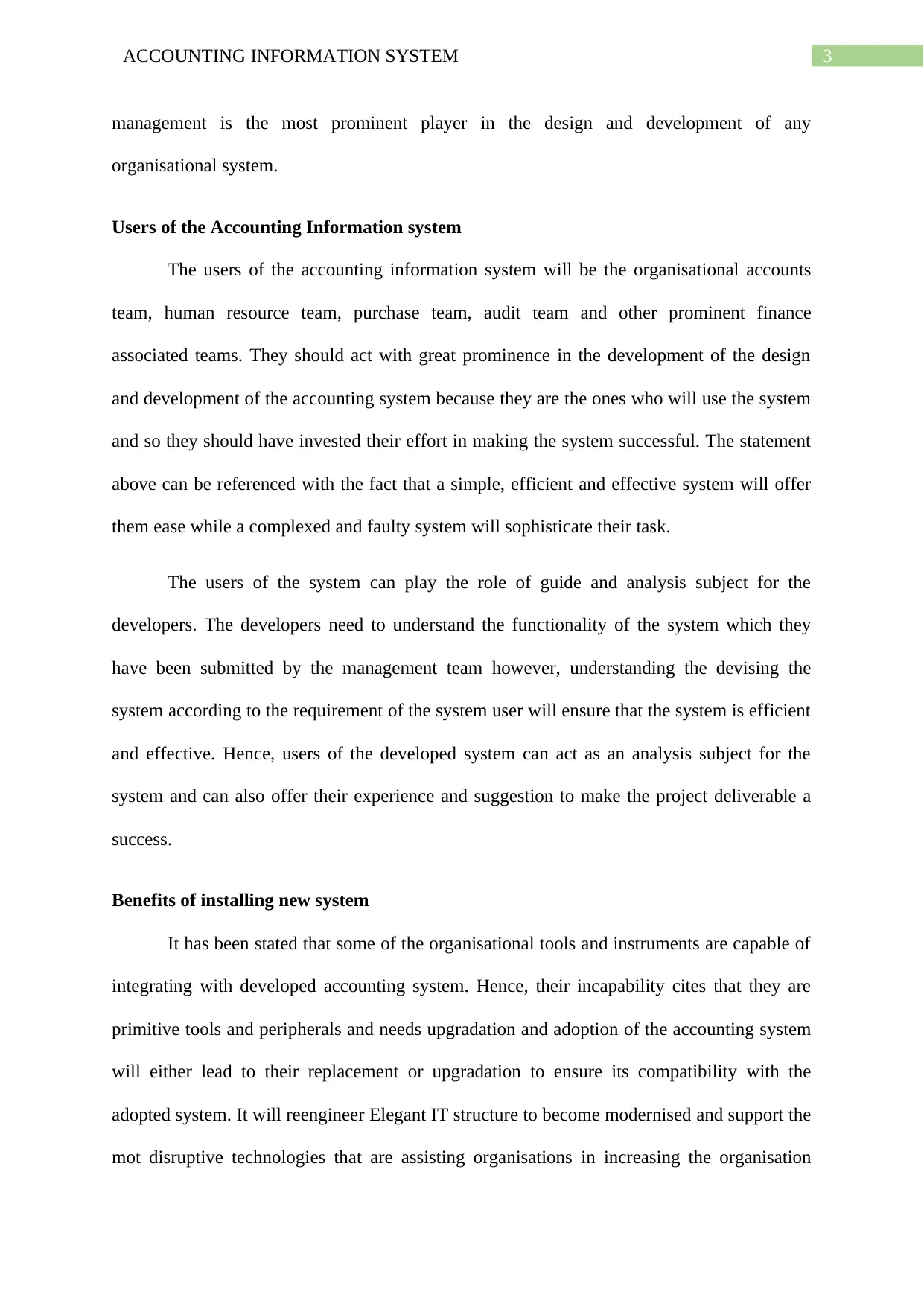
3ACCOUNTING INFORMATION SYSTEM
management is the most prominent player in the design and development of any
organisational system.
Users of the Accounting Information system
The users of the accounting information system will be the organisational accounts
team, human resource team, purchase team, audit team and other prominent finance
associated teams. They should act with great prominence in the development of the design
and development of the accounting system because they are the ones who will use the system
and so they should have invested their effort in making the system successful. The statement
above can be referenced with the fact that a simple, efficient and effective system will offer
them ease while a complexed and faulty system will sophisticate their task.
The users of the system can play the role of guide and analysis subject for the
developers. The developers need to understand the functionality of the system which they
have been submitted by the management team however, understanding the devising the
system according to the requirement of the system user will ensure that the system is efficient
and effective. Hence, users of the developed system can act as an analysis subject for the
system and can also offer their experience and suggestion to make the project deliverable a
success.
Benefits of installing new system
It has been stated that some of the organisational tools and instruments are capable of
integrating with developed accounting system. Hence, their incapability cites that they are
primitive tools and peripherals and needs upgradation and adoption of the accounting system
will either lead to their replacement or upgradation to ensure its compatibility with the
adopted system. It will reengineer Elegant IT structure to become modernised and support the
mot disruptive technologies that are assisting organisations in increasing the organisation
management is the most prominent player in the design and development of any
organisational system.
Users of the Accounting Information system
The users of the accounting information system will be the organisational accounts
team, human resource team, purchase team, audit team and other prominent finance
associated teams. They should act with great prominence in the development of the design
and development of the accounting system because they are the ones who will use the system
and so they should have invested their effort in making the system successful. The statement
above can be referenced with the fact that a simple, efficient and effective system will offer
them ease while a complexed and faulty system will sophisticate their task.
The users of the system can play the role of guide and analysis subject for the
developers. The developers need to understand the functionality of the system which they
have been submitted by the management team however, understanding the devising the
system according to the requirement of the system user will ensure that the system is efficient
and effective. Hence, users of the developed system can act as an analysis subject for the
system and can also offer their experience and suggestion to make the project deliverable a
success.
Benefits of installing new system
It has been stated that some of the organisational tools and instruments are capable of
integrating with developed accounting system. Hence, their incapability cites that they are
primitive tools and peripherals and needs upgradation and adoption of the accounting system
will either lead to their replacement or upgradation to ensure its compatibility with the
adopted system. It will reengineer Elegant IT structure to become modernised and support the
mot disruptive technologies that are assisting organisations in increasing the organisation
Paraphrase This Document
Need a fresh take? Get an instant paraphrase of this document with our AI Paraphraser
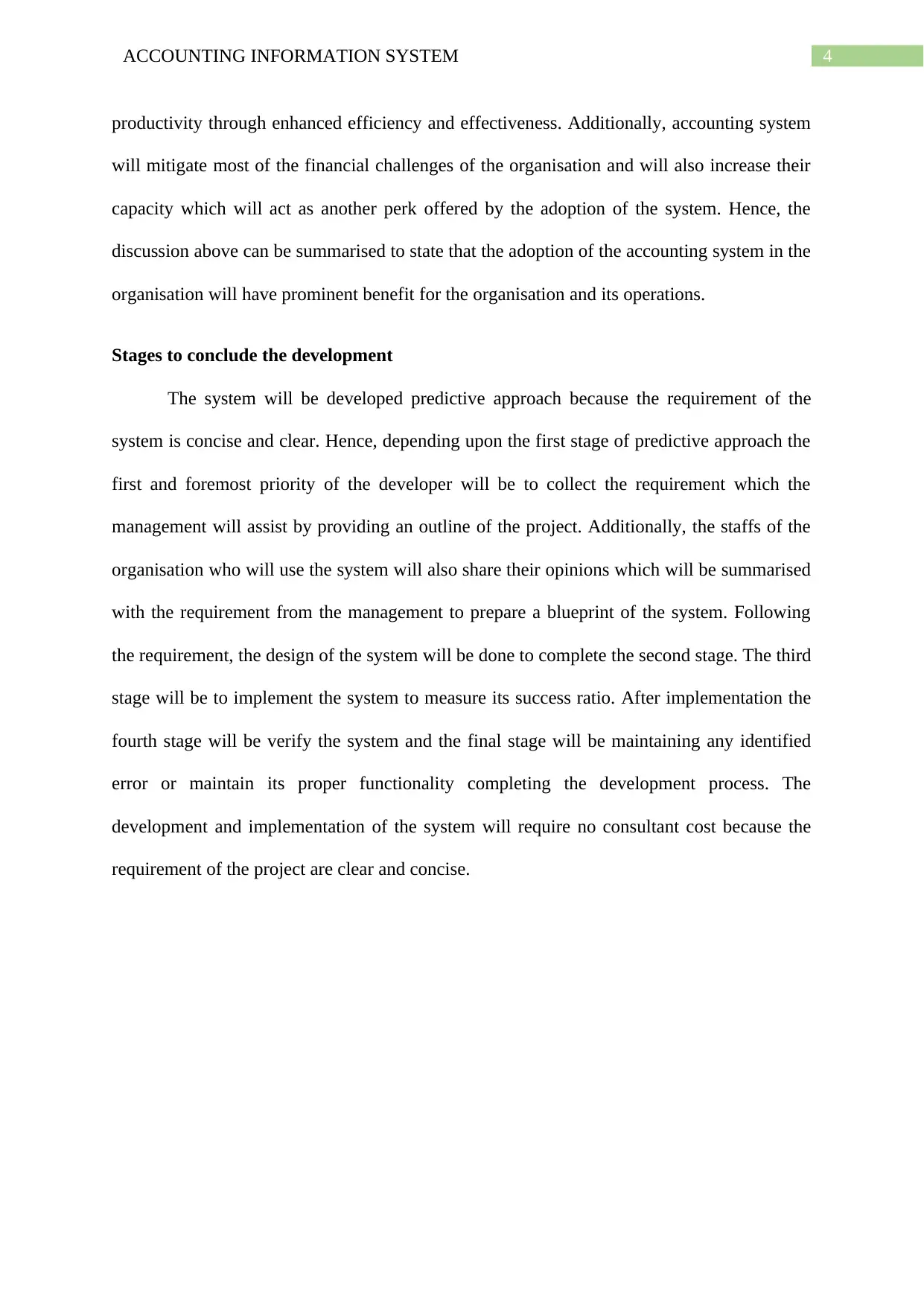
4ACCOUNTING INFORMATION SYSTEM
productivity through enhanced efficiency and effectiveness. Additionally, accounting system
will mitigate most of the financial challenges of the organisation and will also increase their
capacity which will act as another perk offered by the adoption of the system. Hence, the
discussion above can be summarised to state that the adoption of the accounting system in the
organisation will have prominent benefit for the organisation and its operations.
Stages to conclude the development
The system will be developed predictive approach because the requirement of the
system is concise and clear. Hence, depending upon the first stage of predictive approach the
first and foremost priority of the developer will be to collect the requirement which the
management will assist by providing an outline of the project. Additionally, the staffs of the
organisation who will use the system will also share their opinions which will be summarised
with the requirement from the management to prepare a blueprint of the system. Following
the requirement, the design of the system will be done to complete the second stage. The third
stage will be to implement the system to measure its success ratio. After implementation the
fourth stage will be verify the system and the final stage will be maintaining any identified
error or maintain its proper functionality completing the development process. The
development and implementation of the system will require no consultant cost because the
requirement of the project are clear and concise.
productivity through enhanced efficiency and effectiveness. Additionally, accounting system
will mitigate most of the financial challenges of the organisation and will also increase their
capacity which will act as another perk offered by the adoption of the system. Hence, the
discussion above can be summarised to state that the adoption of the accounting system in the
organisation will have prominent benefit for the organisation and its operations.
Stages to conclude the development
The system will be developed predictive approach because the requirement of the
system is concise and clear. Hence, depending upon the first stage of predictive approach the
first and foremost priority of the developer will be to collect the requirement which the
management will assist by providing an outline of the project. Additionally, the staffs of the
organisation who will use the system will also share their opinions which will be summarised
with the requirement from the management to prepare a blueprint of the system. Following
the requirement, the design of the system will be done to complete the second stage. The third
stage will be to implement the system to measure its success ratio. After implementation the
fourth stage will be verify the system and the final stage will be maintaining any identified
error or maintain its proper functionality completing the development process. The
development and implementation of the system will require no consultant cost because the
requirement of the project are clear and concise.
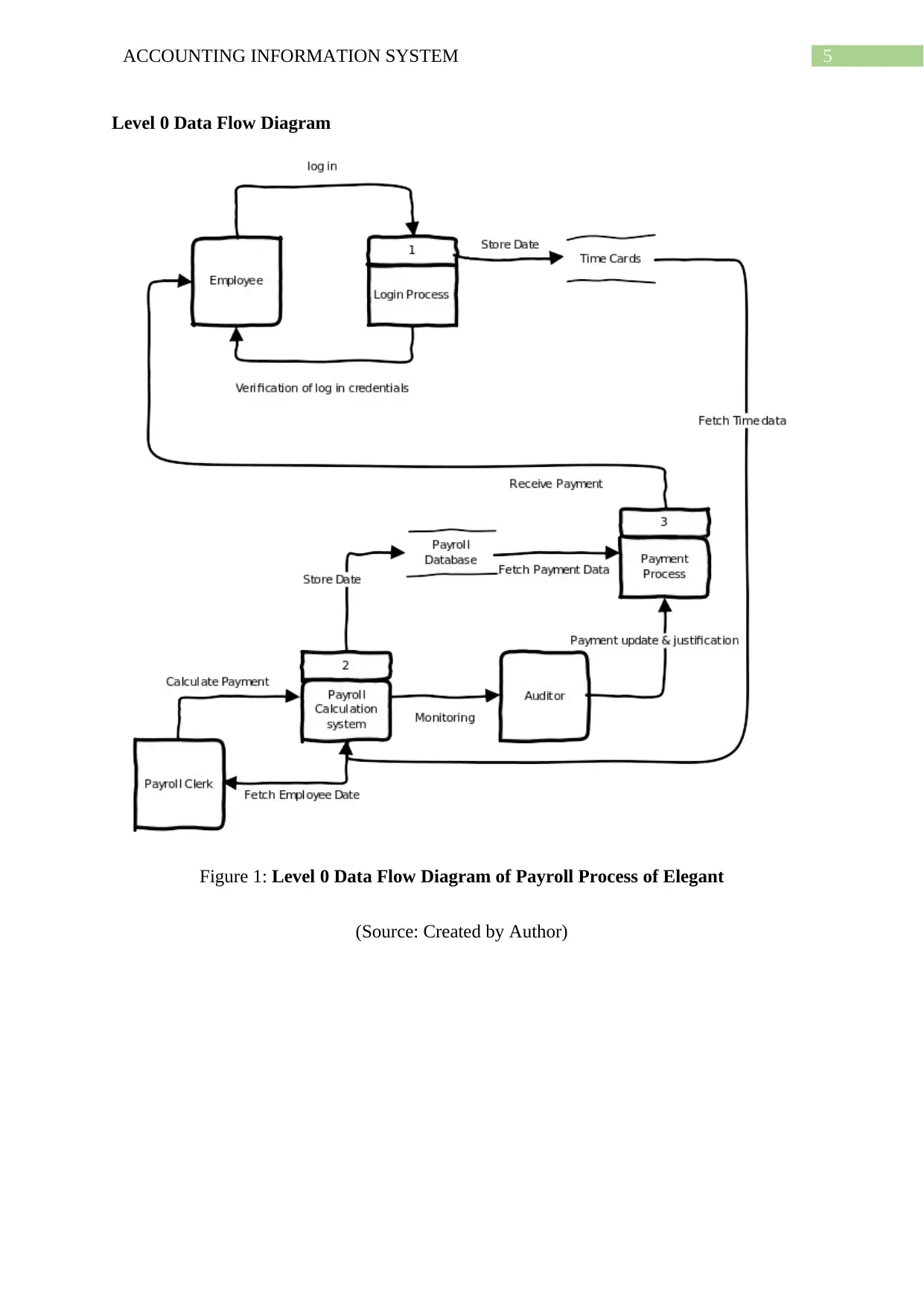
5ACCOUNTING INFORMATION SYSTEM
Level 0 Data Flow Diagram
Figure 1: Level 0 Data Flow Diagram of Payroll Process of Elegant
(Source: Created by Author)
Level 0 Data Flow Diagram
Figure 1: Level 0 Data Flow Diagram of Payroll Process of Elegant
(Source: Created by Author)
⊘ This is a preview!⊘
Do you want full access?
Subscribe today to unlock all pages.

Trusted by 1+ million students worldwide
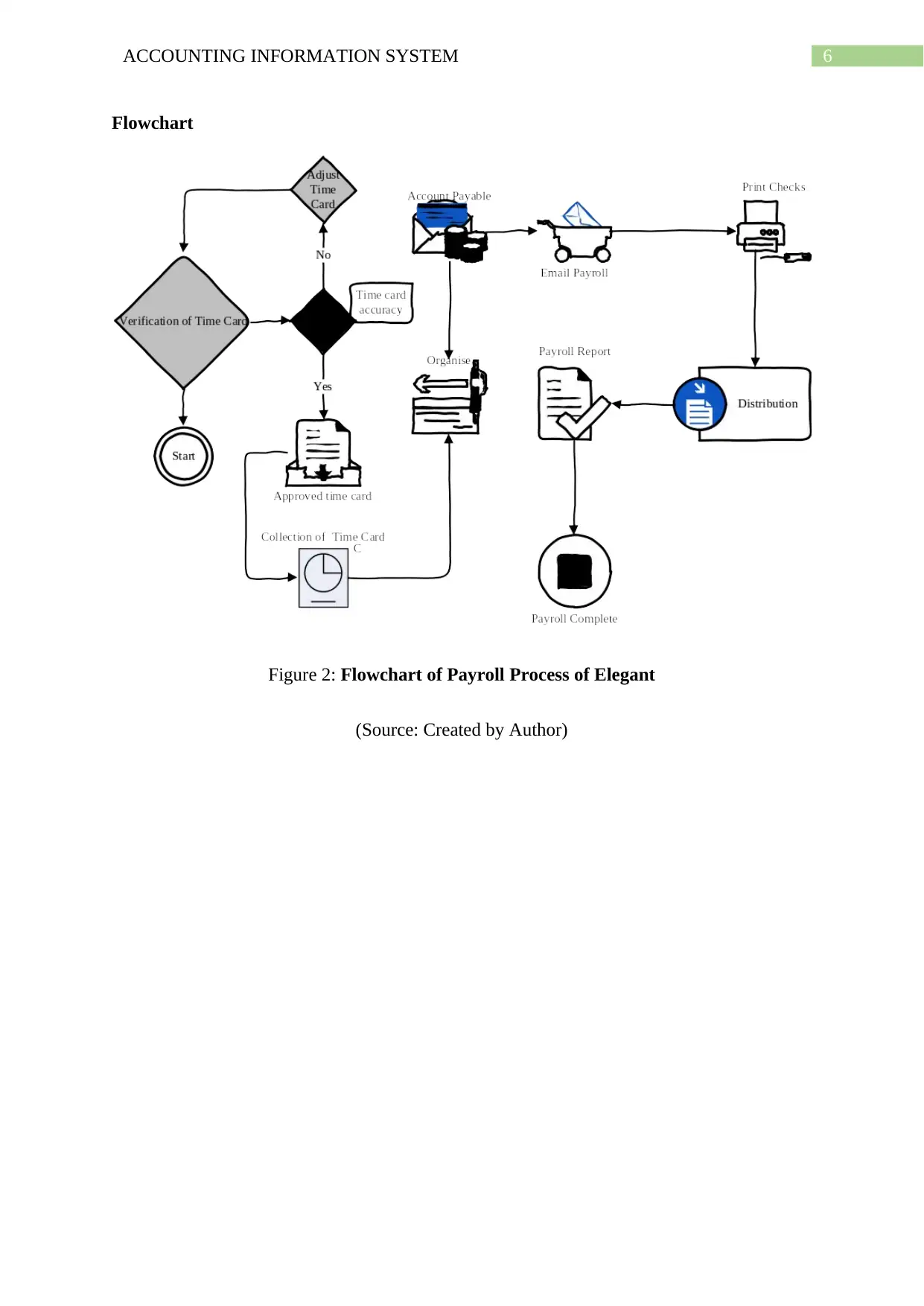
6ACCOUNTING INFORMATION SYSTEM
Flowchart
Figure 2: Flowchart of Payroll Process of Elegant
(Source: Created by Author)
Flowchart
Figure 2: Flowchart of Payroll Process of Elegant
(Source: Created by Author)
Paraphrase This Document
Need a fresh take? Get an instant paraphrase of this document with our AI Paraphraser
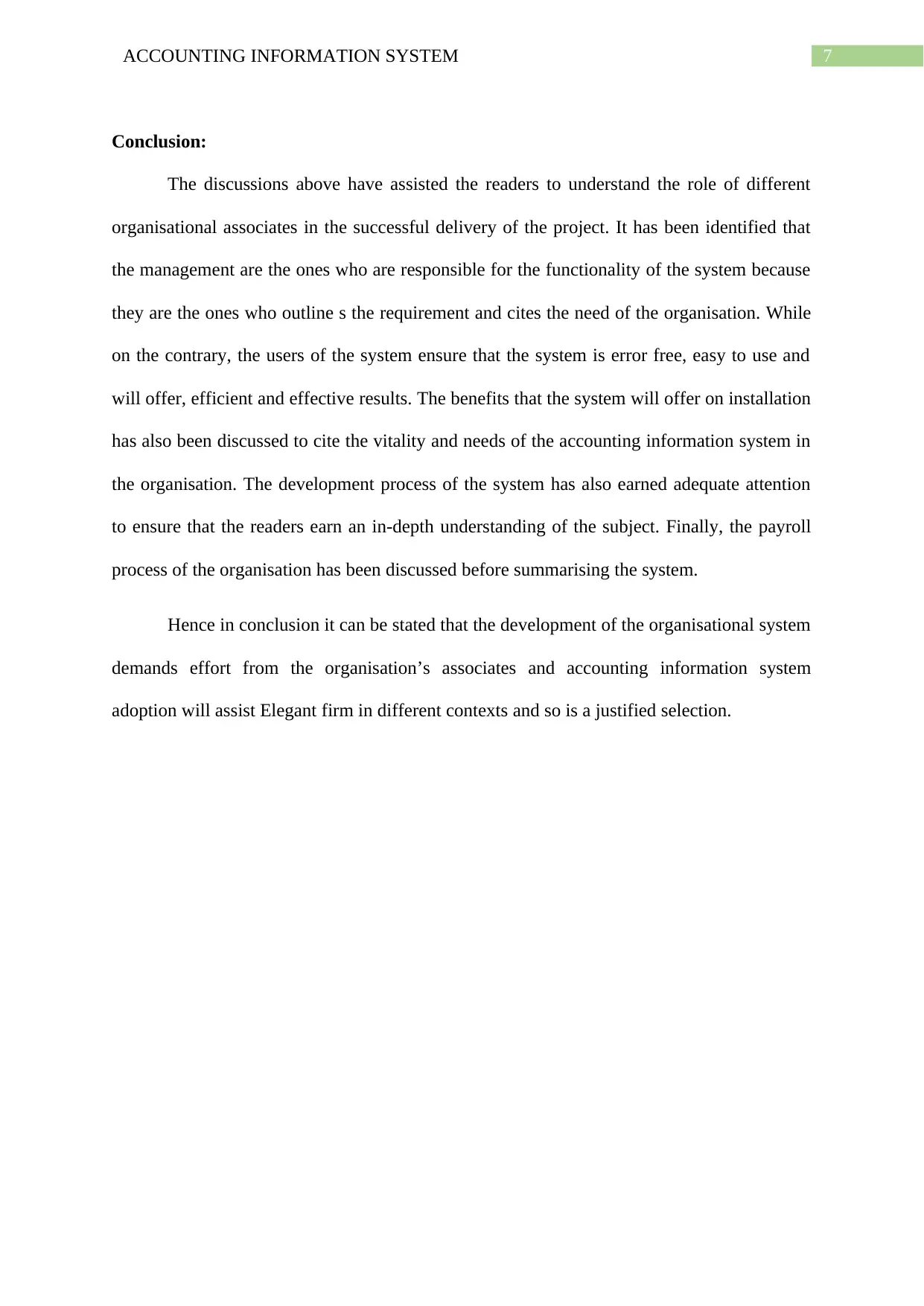
7ACCOUNTING INFORMATION SYSTEM
Conclusion:
The discussions above have assisted the readers to understand the role of different
organisational associates in the successful delivery of the project. It has been identified that
the management are the ones who are responsible for the functionality of the system because
they are the ones who outline s the requirement and cites the need of the organisation. While
on the contrary, the users of the system ensure that the system is error free, easy to use and
will offer, efficient and effective results. The benefits that the system will offer on installation
has also been discussed to cite the vitality and needs of the accounting information system in
the organisation. The development process of the system has also earned adequate attention
to ensure that the readers earn an in-depth understanding of the subject. Finally, the payroll
process of the organisation has been discussed before summarising the system.
Hence in conclusion it can be stated that the development of the organisational system
demands effort from the organisation’s associates and accounting information system
adoption will assist Elegant firm in different contexts and so is a justified selection.
Conclusion:
The discussions above have assisted the readers to understand the role of different
organisational associates in the successful delivery of the project. It has been identified that
the management are the ones who are responsible for the functionality of the system because
they are the ones who outline s the requirement and cites the need of the organisation. While
on the contrary, the users of the system ensure that the system is error free, easy to use and
will offer, efficient and effective results. The benefits that the system will offer on installation
has also been discussed to cite the vitality and needs of the accounting information system in
the organisation. The development process of the system has also earned adequate attention
to ensure that the readers earn an in-depth understanding of the subject. Finally, the payroll
process of the organisation has been discussed before summarising the system.
Hence in conclusion it can be stated that the development of the organisational system
demands effort from the organisation’s associates and accounting information system
adoption will assist Elegant firm in different contexts and so is a justified selection.
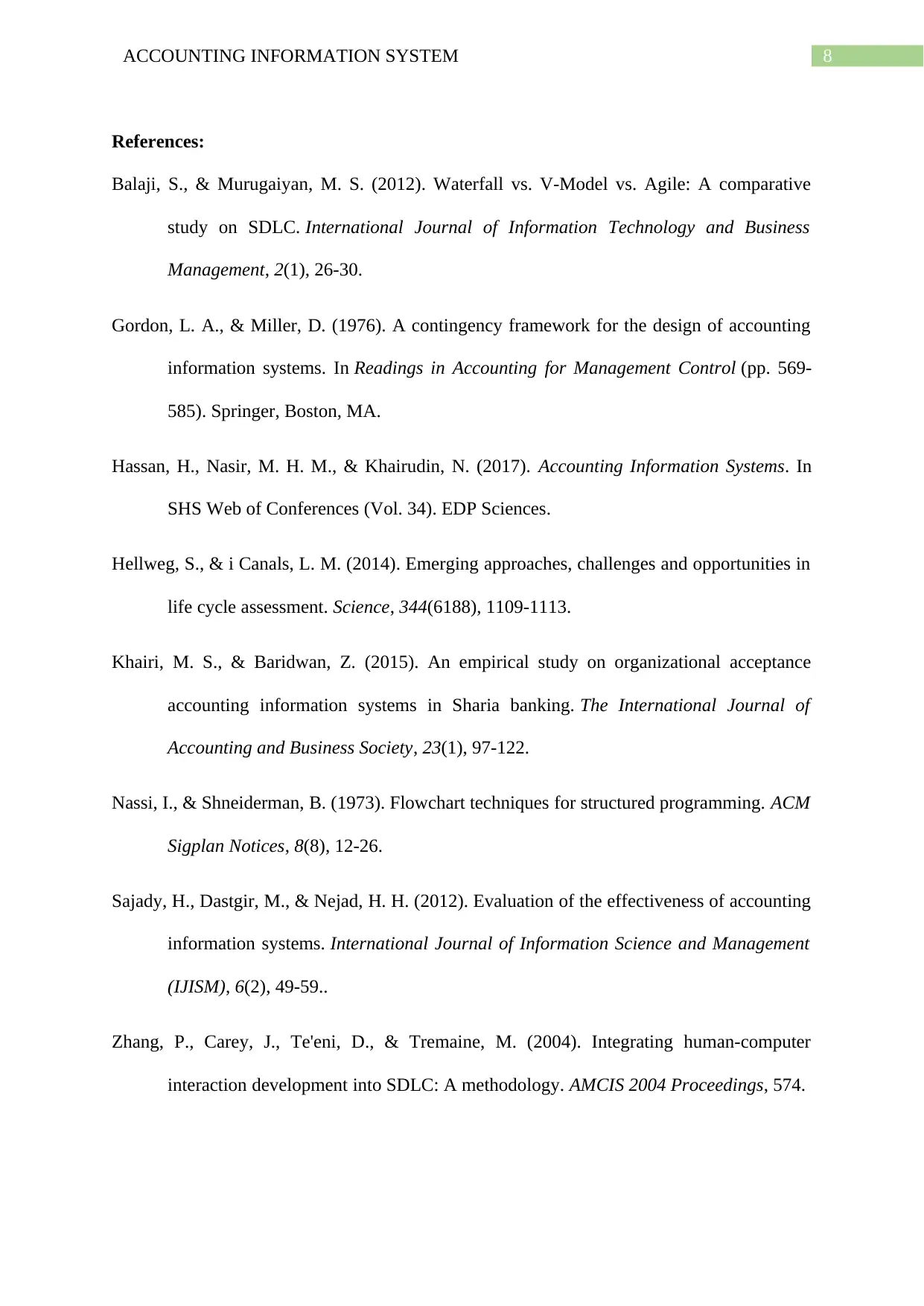
8ACCOUNTING INFORMATION SYSTEM
References:
Balaji, S., & Murugaiyan, M. S. (2012). Waterfall vs. V-Model vs. Agile: A comparative
study on SDLC. International Journal of Information Technology and Business
Management, 2(1), 26-30.
Gordon, L. A., & Miller, D. (1976). A contingency framework for the design of accounting
information systems. In Readings in Accounting for Management Control (pp. 569-
585). Springer, Boston, MA.
Hassan, H., Nasir, M. H. M., & Khairudin, N. (2017). Accounting Information Systems. In
SHS Web of Conferences (Vol. 34). EDP Sciences.
Hellweg, S., & i Canals, L. M. (2014). Emerging approaches, challenges and opportunities in
life cycle assessment. Science, 344(6188), 1109-1113.
Khairi, M. S., & Baridwan, Z. (2015). An empirical study on organizational acceptance
accounting information systems in Sharia banking. The International Journal of
Accounting and Business Society, 23(1), 97-122.
Nassi, I., & Shneiderman, B. (1973). Flowchart techniques for structured programming. ACM
Sigplan Notices, 8(8), 12-26.
Sajady, H., Dastgir, M., & Nejad, H. H. (2012). Evaluation of the effectiveness of accounting
information systems. International Journal of Information Science and Management
(IJISM), 6(2), 49-59..
Zhang, P., Carey, J., Te'eni, D., & Tremaine, M. (2004). Integrating human-computer
interaction development into SDLC: A methodology. AMCIS 2004 Proceedings, 574.
References:
Balaji, S., & Murugaiyan, M. S. (2012). Waterfall vs. V-Model vs. Agile: A comparative
study on SDLC. International Journal of Information Technology and Business
Management, 2(1), 26-30.
Gordon, L. A., & Miller, D. (1976). A contingency framework for the design of accounting
information systems. In Readings in Accounting for Management Control (pp. 569-
585). Springer, Boston, MA.
Hassan, H., Nasir, M. H. M., & Khairudin, N. (2017). Accounting Information Systems. In
SHS Web of Conferences (Vol. 34). EDP Sciences.
Hellweg, S., & i Canals, L. M. (2014). Emerging approaches, challenges and opportunities in
life cycle assessment. Science, 344(6188), 1109-1113.
Khairi, M. S., & Baridwan, Z. (2015). An empirical study on organizational acceptance
accounting information systems in Sharia banking. The International Journal of
Accounting and Business Society, 23(1), 97-122.
Nassi, I., & Shneiderman, B. (1973). Flowchart techniques for structured programming. ACM
Sigplan Notices, 8(8), 12-26.
Sajady, H., Dastgir, M., & Nejad, H. H. (2012). Evaluation of the effectiveness of accounting
information systems. International Journal of Information Science and Management
(IJISM), 6(2), 49-59..
Zhang, P., Carey, J., Te'eni, D., & Tremaine, M. (2004). Integrating human-computer
interaction development into SDLC: A methodology. AMCIS 2004 Proceedings, 574.
⊘ This is a preview!⊘
Do you want full access?
Subscribe today to unlock all pages.

Trusted by 1+ million students worldwide
1 out of 9
Related Documents
Your All-in-One AI-Powered Toolkit for Academic Success.
+13062052269
info@desklib.com
Available 24*7 on WhatsApp / Email
![[object Object]](/_next/static/media/star-bottom.7253800d.svg)
Unlock your academic potential
Copyright © 2020–2025 A2Z Services. All Rights Reserved. Developed and managed by ZUCOL.




